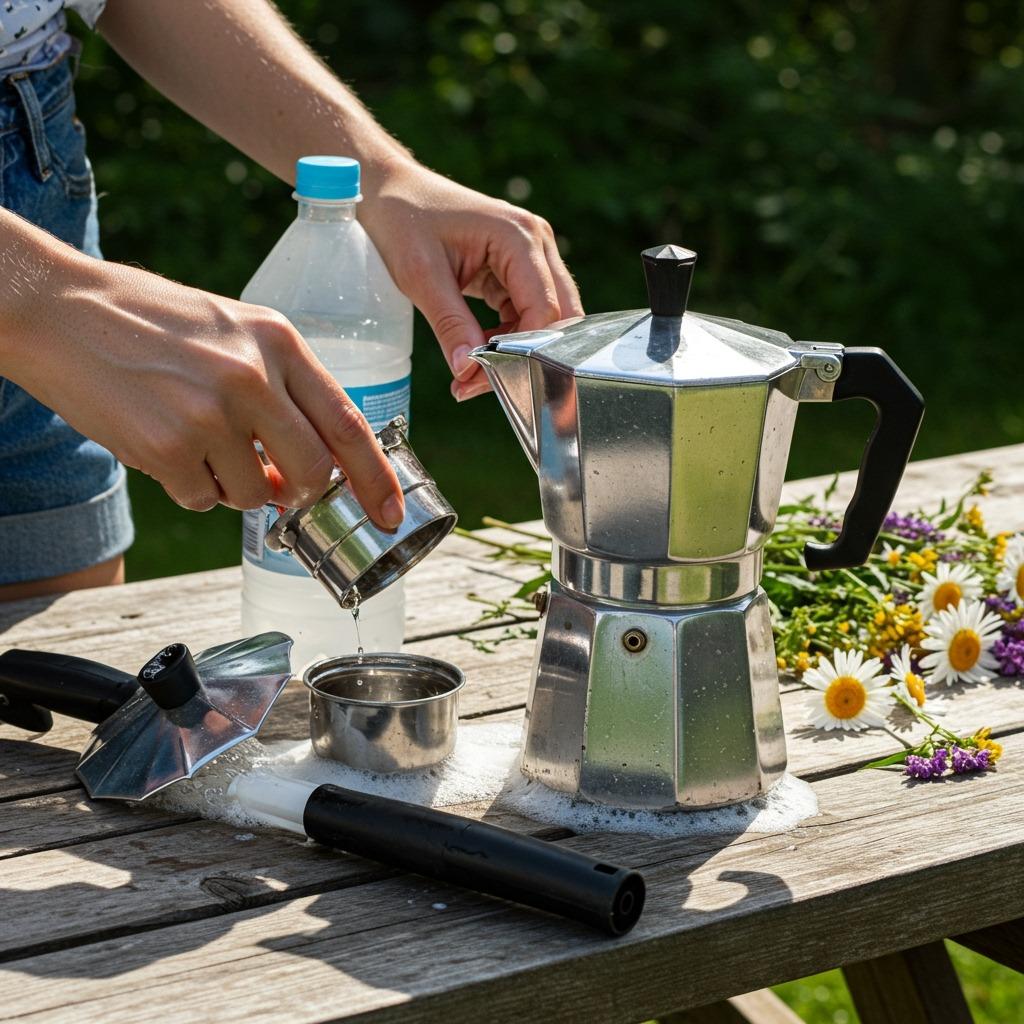
Nothing signals a return from the beaten path like the comforting aroma of home-brewed coffee. But if, after a weekend hiking or fishing, your cup tastes… off—flat, gritty, or not quite like you remember—your coffee pot is probably begging for attention. After a decade spent savoring sunrise mugs on mountaintops and cleaning up disaster spillage inside tents, my best advice holds true: treat your coffee pot with the same respect as your hiking boots or favorite camp jacket.
And just like preparing for a trip means choosing the most comfortable, durable camping clothes or smart ways to stay warm, mastering the art of a deep clean can transform every cup—whether on the back patio or in the midst of a bustling home.
Why a Clean Coffee Pot is Essential for Adventurers
Coffee is fuel, ritual, and comfort. If you’re a regular camper or hiking enthusiast, you know the difference between a mug of “swamp water” and a robust, satisfying blend. But few people realize how quickly coffee oils and mineral deposits cling to glass, metal, and plastic, affecting both taste and machine longevity.
Over time, lingering grime traps old flavors and can even clog vital parts—making the next brew taste bitter, murky, or as stale as wet socks after a river fording. Regular cleaning preserves not just your coffee’s flavor, but also the “clean start” feeling that makes outdoor mornings so addictive.
Making equipment care part of your post-adventure routine is like arranging your gear for the next trip. It’s all about enjoying each little moment—whether you’re sipping with friends in the backyard or prepping one more thermos for a primitive camping adventure.
The Step-By-Step Ultimate Deep Clean
The gold standard method will work for most home drip pots, pour-overs, Moka pots, and even single-serve machines. You just need water, vinegar, baking soda, plus a little know-how.
1. Empty and Prep
Take apart everything removable—carafe, basket, lids, reusable filters—and knock out loose coffee grounds. If you’re using a camp-style percolator, empty the grounds tube and inspect the base for grit.
2. Bust the Buildup: Vinegar Wash
Mix equal parts white vinegar and water—usually two to four cups, depending on your reservoir size—and pour it in. Start a brew cycle as usual, but pause it halfway for about 30 minutes to let the acidic mix soften stubborn limescale and coffee oils.
While you wait, use a soft brush or an old toothbrush to scrub the basket and filter. For seriously crusty pots, swirling the vinegar-water mix in the carafe does wonders.
When finished, dump it out (carefully—vinegar-scented steam is intense). Then fill the reservoir with clean water and run at least two more cycles, ensuring all the acid and loosened gunk gets flushed away.

3. Go Deeper with Baking Soda
If you still see brownish stains or smell stale coffee, sprinkle a tablespoon of baking soda in the pot or carafe. Add just enough water to make a paste and scrub with a soft sponge or bottle brush. Baking soda’s gentle abrasiveness lifts stains without scratching. Rinse thoroughly when done. If you use travel mugs or insulated camp cups, this trick works wonders there, too.
4. Don’t Forget Small Parts
Wipe down warming plates, buttons, and the exterior shell with a damp cloth. Soap is fine, but avoid soaking anything with electrical parts. Let everything air-dry before reassembling.
Cleaning filters and baskets with soapy water after each use is a lifesaver—and if you’ve upgraded to a reusable mesh filter, give it a vinegar soak monthly to prevent oil buildup. Just as you’d prep a tent before rain, investing a little time here saves frustration down the line.
Troubleshooting: When a Clean Isn’t Enough
Stubborn smells or funky tastes after a deep clean? Try these—just like you’d troubleshoot your camp breakfast routine after a few burnt pancakes:
- Run two extra rounds of clean water. Vinegar and baking soda can occasionally linger.
- Scrub rubber and silicone parts. They absorb odors; a soak in lemon water can help.
- Replace old filters. Paper or charcoal filters can harbor smells long after washing.
- Check your water. If your tap water is hard or tastes off, use filtered water for both cleaning and brewing.
Camp-Ready Cleaning Tips for Outdoor Coffee Gear
Portable presses, pour-overs, and rugged steel pots deserve love, too. On the trail, rinse your kit with clean water after each use. For the occasional deep clean, assemble your favorites on the porch or picnic table—just like camp cooking.
Tip: Store a small bottle of vinegar and a travel brush in your gear box. Nothing’s worse than making perfect cowboy coffee, only to taste last month’s burnt grounds. If you’re curious about classic camp brews, check out tips for how to make cowboy coffee on your next primitive campout.

The Secret to Everyday Freshness: Simple Habits
- Rinse the coffee pot after every use. Just a quick splash and air dry.
- Wipe up drips and spills as soon as they happen, especially under the carafe.
- Weekly mini-wash: Soak baskets and filters in warm, soapy water, then rinse.
- Monthly deep clean: Use vinegar or lemon for glass, baking soda for stainless or insulated vessels.
Integrating these habits makes daily cleanup quick and protects against the kind of build-up that ruins Monday mornings—and long after you’ve packed away the camp stove, you’ll appreciate the taste of real, clean coffee at home.
Want to keep your routine fun? Mix things up with 25 creative things to do while camping, including wild ways to savor great coffee in any season.
Seasonal Routine: Tackling Tough Stains
Hot summers mean more iced coffee, which can leave sticky sugar and dairy traces. Winter camping leads to strong, dark brews that sit in pots for hours. Each season brings its own challenges, but the solutions stay the same:
- Use a non-scratch sponge for glass or stainless steel
- Avoid abrasive powders on plastic.
- If you spill milk or creamer, wash it immediately to avoid sour odors.
- Lemon juice removes lingering smells—run through one brew cycle mixed with water, then rinse
Long hikes, fishing trips, and cross-country drives mean accidental spills—on gear, carpets, and sometimes even sleeping bags. For all sorts of messes (including coffee stains in odd places), household pros are invaluable: Good Housekeeping has comprehensive tips for every cleaning need.

Caring for Specialty Coffee Makers: French Press, Aeropress, and Cold Brew
Each device has unique needs:
- French Press: Disassemble and rinse all parts after each use. Clean mesh filters with soapy water, and soak in a vinegar solution monthly. Dry thoroughly to prevent odors and mold.
- Aeropress: Pop out the plunger, rinse, and wash with mild soap. For deep cleans, immerse both parts in warm water with a dash of vinegar.
- Cold Brew Pitchers: Avoid letting grounds sit for days. Wash vessels with a baking soda paste to eliminate lingering oils.
These habits fit seamlessly into your weekend gear clean-up, and make every adventure home (and back out again) taste smoother.
Make Cleaning a Habit, Not a Hassle
Just like layering your camping clothes or prepping for unpredictable weather, a little prep saves a lot of trouble. Keeping a bottle of vinegar, baking soda, and a non-scratch sponge on hand means you’re always ready for the next cup—even if you’ve just trekked back from the wild.
And if you really want to optimize your morning coffee or create rituals that keep you energized all year, REI’s expert maintenance advice is tailored for adventure seekers of all skill levels.
Frequently Asked Questions
How often should I deep clean my coffee pot?
Ideally, run a deep clean with vinegar every one to two months, or after every thirty uses. For heavy use (like prepping coffee for a whole camp crew), consider cleaning every two weeks.
Can I use lemon juice instead of vinegar?
Yes—lemon juice is gentler and works well for both glass and stainless steel, offering a fresh scent and natural cleaning power.
What’s the best way to clean a percolator in the wild?
Use boiling water and a handful of coarse sand or grit as a scrub for stuck-on residues, rinse thoroughly, and allow to air dry before repacking. Always clean gear thoroughly at home before storage.
How do I fix lingering smells after cleaning?
Try soaking removable parts in a solution of lemon juice and water or baking soda overnight, then rinse and dry well before reassembling.
Do I need specialty products to clean my coffee maker?
Most home and camp coffee equipment can be maintained with common kitchen ingredients. Specialty cleaners work quickly but are rarely essential unless you have very hard water or advanced appliances.
Final Sip: Clean Pot, Clear Mind
Whether you’re watching the stars fade on a solo backpack or brewing up one last pot before everyone packs out, a truly fresh cup is an adventurer’s reward. Take pride in clean gear—at home, in camp, or on the open road. Your coffee and your mornings will always taste better for it.
As you plan your next outing, remember: a little preparation goes a long way. For more ways to bring joy and flavor to your journeys—indoors or out—find inspiration from Outside Online, a go-to for every modern explorer’s home and campsite.

